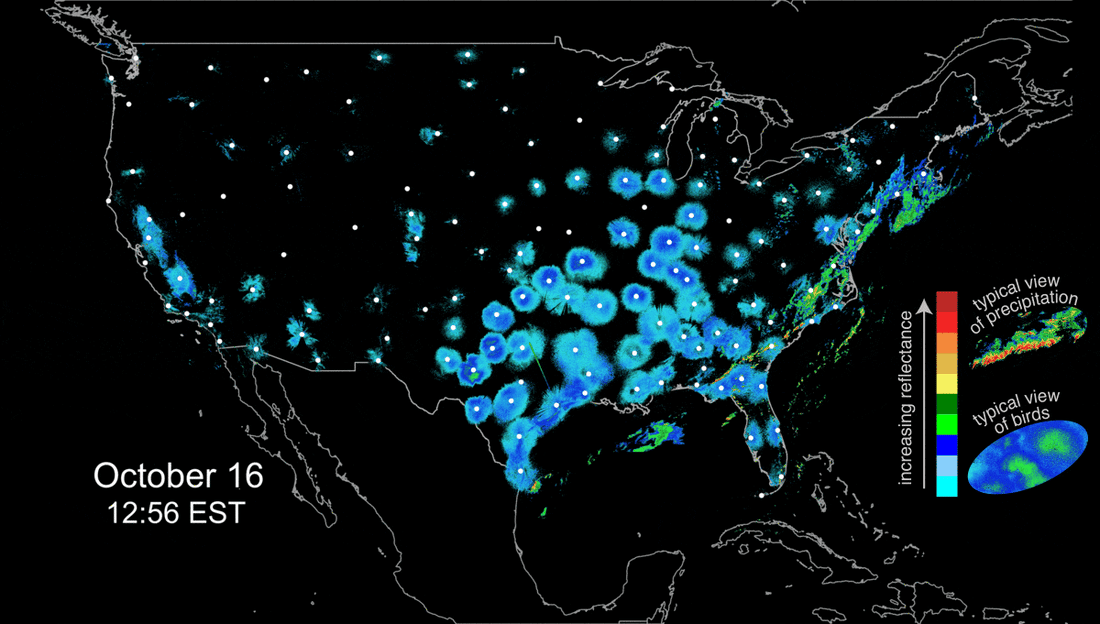
Unlock Fall Birding Magic: How Birdcast Transforms Your Migration Experience
Brett KarleyTL;DR
Check out the maps on Birdcast. Set an alert for your city. When your area lights up, or there’s a significant volume of migrants predicted for a night, go birding the next morning.
Improve Your Fall Birding Experience with Birdcast
As the crisp air of fall begins to settle in, birders across the country dive into one of the most thrilling times of the year: fall migration. Unlike the hurried spring migration, fall offers a unique advantage—birds tend to linger longer during their journey south, not in as much of a rush. This extended stay provides bird enthusiasts with a spectacular opportunity to observe a wide range of species. To make the most of this migration period, having the right tools and resources is essential. One of the most invaluable resources available today is Birdcast. In this article, we’ll explore how Birdcast can enhance your fall birding experience with its real-time migration forecasts, detailed migration maps, and other essential tools designed for birders.

Why Birdcast is Essential for Fall Birding
Birdcast is an innovative platform that leverages advanced meteorological data and bird migration models to provide birders with precise and up-to-date information about bird movements. Understanding the patterns of bird migration is crucial for maximizing your chances of witnessing the most species during the fall migration. Here’s why Birdcast should be your go-to resource this fall:

Migration Forecast
One of the most impressive features of Birdcast is its migration forecast. These forecasts are generated using state-of-the-art models that analyze weather radar, bird behavior, and historical migration data. The result is a highly accurate prediction of when and where birds are likely to be moving. By checking these forecasts regularly, you can plan your outings to coincide with peak migration periods, ensuring that you don’t miss out on any of the action. You can also set an alert for your city.

Detailed Migration Maps
In addition to migration forecast, Birdcast provides detailed migration maps that show the movement of birds across the continent in real time. These maps are updated continuously and offer a visual representation of bird activity, making it easier for birders to identify hotspots and trends. Whether you’re a seasoned birder or a beginner, these maps are an invaluable tool for locating the best birding spots and times to go birding during the fall migration.

Nighttime Bird Migration Tracking
Most bird species migrate at night, making it difficult for birders to observe their movements. However, with Birdcast's nighttime tracking, you can get a glimpse of the nocturnal migration activity in your area. This feature is particularly useful for deciding which mornings to go out birding and to identify areas where large numbers of birds have landed overnight.
Birdcast Local Migration Alerts
For those who want to stay on top of migration activity as it happens, Birdcast provides local migration alerts. These alerts notify you of significant migration events in your area and forecasts for the next few days. Whether you’re at home or on the go, these alerts ensure that you never miss an opportunity to witness a migration spectacle.
How Birdcast Uses Radar Technology
Radar Technology Evolution
Originally developed for detecting aircraft during WWII, radar technology has become essential for studying bird migration. By capturing data on various atmospheric objects, including birds, radar has revolutionized ornithology.
Radar Ornithology
The field of radar ornithology emerged when early radar operators noticed unexplained "angels" on screens, which were later identified as birds by pioneering ornithologists. This discovery marked a significant advancement in our understanding of bird migration.
NEXRAD and Dual-Pol Technology
Advancements like the Next Generation Radar (NEXRAD) and dual-polarization have significantly improved the ability to distinguish birds from meteorological events and other atmospheric objects. These technologies allow for more accurate tracking of bird movements.
Challenges in Data Analysis
Distinguishing between birds, bats, and insects in radar data is complex due to overlapping flight patterns, speeds, and behaviors, especially during migration seasons. This challenge highlights the need for ongoing research and refinement of radar techniques.
Community Contribution
Birdcast integrates radar data with eBird observations to enhance the accuracy of identifying bird species. This collaboration emphasizes the importance of community involvement in "ground-truthing" radar data, ensuring that the information is as precise as possible.
Real-Time Bird Tracking
Birdcast uses radar data to provide live migration maps and forecasts, helping the public track bird movements and contribute to ongoing research. This real-time tracking is a powerful tool for birders and researchers alike.
Ongoing Research Needs
Despite technological advancements, further innovation is required to distinguish specific bird species in radar data. Community observations remain critical for accurate analysis and continued improvement in bird migration tracking.
Maximizing Your Birding Experience with Birdcast
Explore the Migration Dashboard
Make sure to check out the Migration Dashboard on Birdcast, which shows you trends, historical data, and will let you know which species are on the move and which ones to expect moving through your area.
Planning Your Birding Outings
Bird migration is a dynamic process that can vary from day to day, depending on weather conditions and other factors. By monitoring Birdcast’s migration forecasts, you can time your outings to coincide with peak migration activity. The hard part is done for you. When the map lights up with a high volume of activity in your area, simply head out the next morning. It’s that simple. You’ll be amazed at how quickly the bird scene can change—new species arriving overnight, others leaving, and overall bird numbers shifting. Last fall, I visited a spot one day and saw no Western Tanagers. After a high-volume migration night, the next day, I returned to the same location and counted over 30. BirdCast boosts your chances of encountering a wide variety of species and helps you maximize your time in the field.
Staying Informed with Local Alerts
Birding is unpredictable, with migration patterns shifting rapidly due to changes in weather and other factors. Birdcast’s alerts keep you informed of these changes to take advantage of any unexpected birding opportunities.
Additional Tips for Fall Birding Success
- Use eBird and submit your observations: eBird can help you find the best hotspots to visit and see which kinds of birds are being observed in your area. When you keep track of the birds you see and submit a checklist, you’re not only providing valuable data for ornithologists, you’re helping Birdcast get better at forecasting.
- Study Local Bird Species: Before heading out, take some time to familiarize yourself with the bird species that are likely to be migrating through your area. This will help you identify birds more quickly in the field and make your birding experience more enjoyable.
- Bring the Right Gear: Don’t forget your binoculars. While some birders prefer traditional field guides, others rely on apps for quick identification. A camera can also be a great addition—not for award-winning shots, but for capturing details you can study later or to help with IDs you missed in the field. Dress for the weather and pack snacks and water if you’ll be out for an extended period.
- Join a Birding Group: Birding with others can be a great way to learn more about birds and share your passion with like-minded individuals. Consider joining a local birding group or participating in organized birding events during the fall migration.
- Follow the Birds: This is a key mantra for me: no matter how familiar you are with a location or how confident you feel about where to go, always follow the birds when you arrive. If you hear a flurry of activity, investigate it. If you see a bunch of birds in an unexpected place, go there. Some of my most incredible birding experiences have come from this spontaneous approach. Often, the most rewarding encounters happen when you least expect them.












![The Ultimate Gift Guide for Bird Lovers: Unique Gifts for Birders and Birdwatchers [Updated for 2025]](http://birdclub.club/cdn/shop/articles/Ultimate_Gift_Guide_Composite_Image-bird-club-updated-2025-v2.jpg?v=1764980364&width=533)

